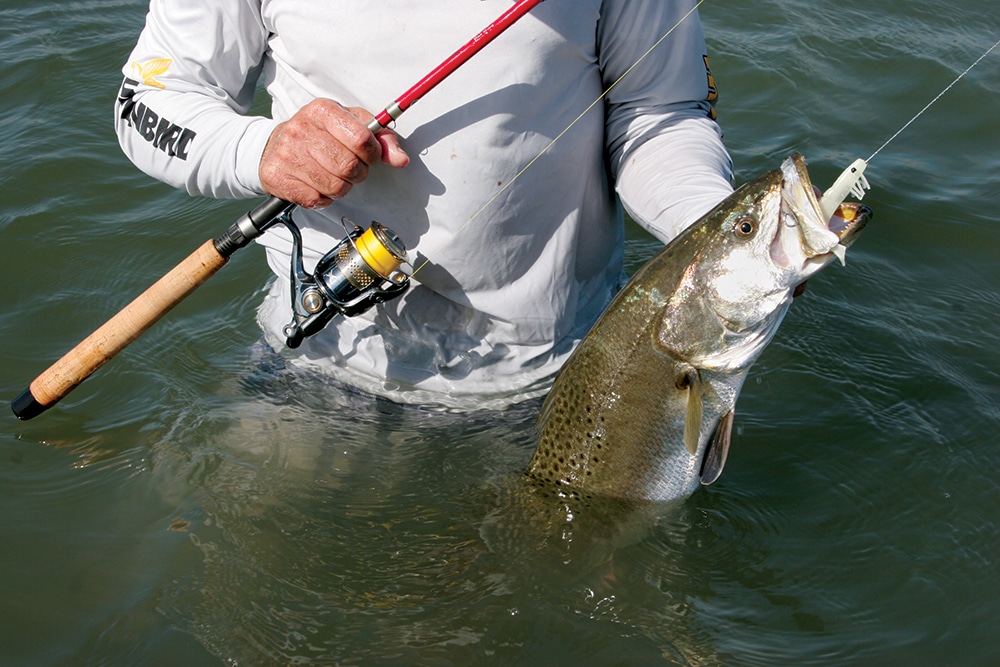
Florida’s northeast coast lies squarely in the center of what one would consider prime spotted seatrout habitat. The area also receives less fishing pressure than many more-publicized trout hot spots, so it might just offer some of the best opportunities available. With miles of Intracoastal Waterway combined with the St. Johns River mouth, Jacksonville is a sure bet.
What happened one balmy night with friend Chris Holleman shows how outstanding the spotted seatrout fishing has become in northeast Florida.
We met at a downtown Jacksonville boat ramp, where we launched his 18-foot skiff in the St. Johns River as dusk settled and dock lights began to twinkle. He likes a strong-running tide for trout, so the heavy current carries bait and shrimp under dock lights and turns predators on.
First stop was an industrial dock, not far from where the Jacksonville Jaguars play. From the bow, Holleman eased his skiff near dock pilings heading into the current. The water was about eight feet deep, and we fired ¼-ounce grub jigs under the dock, allowing them to swing on a taut line.
Holleman immediately caught and released an under-size 14-inch trout, then a second, and was fighting a third when I hooked up, and for the next three hours, we had nonstop, every-cast action. And as the evening got darker, the tide stronger, and more dock lights came on, the fishing got better.
At one dock, the hard-falling tide pushed so strong through the pilings that it formed a dozen funnels of rushing water under the lights. In every slot and behind every piling in slack water, trout boiled on shrimp and baitfish jumping to escape.
What I was witnessed was hard to believe — in the heart of the city, no less.
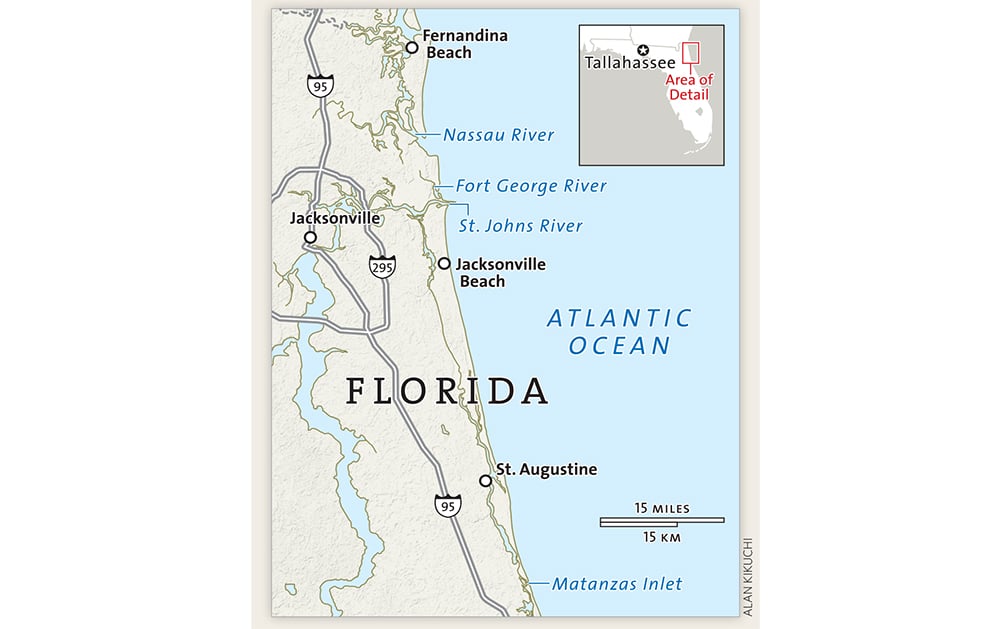
Holleman moved us around to four or five lighted docks over four hours, plus stopping to cast to a few submerged points, bulkheads and bridge pilings. There were trout at every stop.
“You got to catch and release lots of 12- to 15-inch seatrout to get a limit of 16- to 20-inchers,” he said smiling as we loaded up for home. “But I’m not complaining, because 100-fish nights are possible, all on lures.”
That night with Holleman wasn’t a fluke either.
Trout fishing is as good as it’s been in several decades throughout the region.
Hot Trout Fishing in Jacksonville Florida
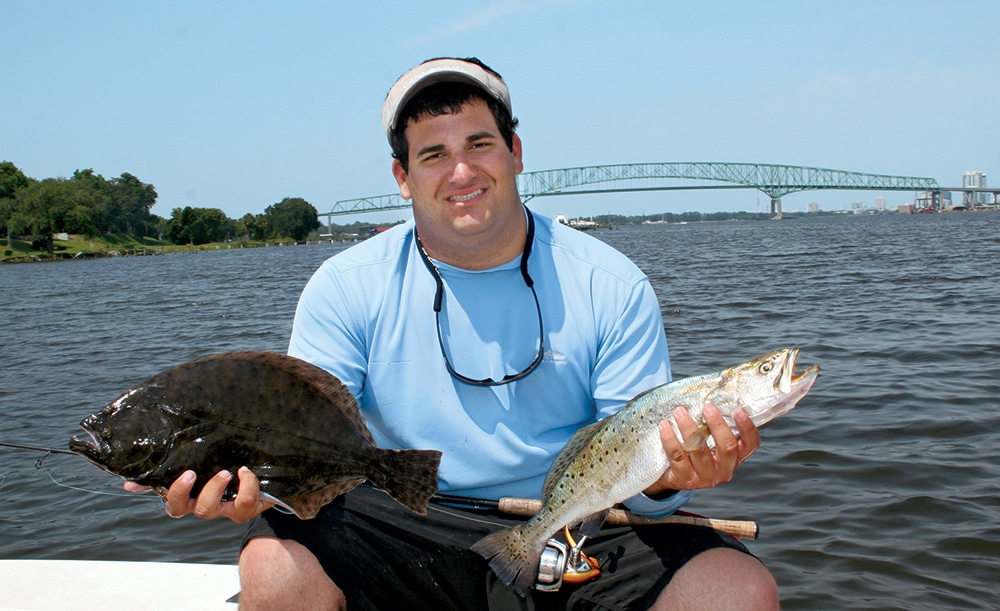
What has caused this surge in trout fishing? That’s a matter of speculation, but for starters, the abundance of bait in the region can at times be remarkable, as wave after wave of mullet, menhaden, glass minnows, and shrimp wash along with currents and tides. That’s often key to bumper crops of sport fish, and it’s one important clue to pinpointing productive spots for northeast Florida trout.
Find the bait, and you’ve likely found the trout, plus other species too, including redfish and flounder. In the past few years, I’ve lost count of the number of trout/redfish/flounder “slams” I’ve had. One day during summer stands out, as a buddy and I boated a double limit of trout and redfish (two each), five flounder to 4 pounds, a pair of 3-pound common weakfish (called “yellowmouths” locally), and a 6-pound striped bass, plus countless throw-back croakers, all with jigs and small diving plugs in four hours of falling tide.
There’s great fishing available year-round, but trout hold to seasonal patterns revolving around water temperature and where bait migrate.
Wintertime Fishing is Boom or Bust in Florida
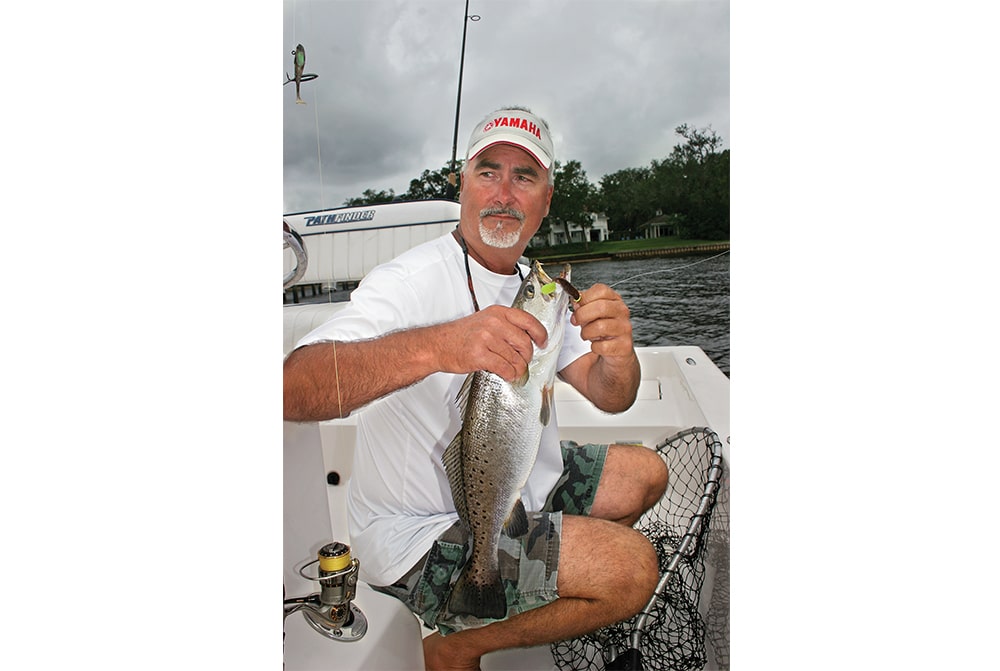
The toughest fishing of the year is December through February, with water temperatures at their lowest, into the 40s and 50s. Most baitfish and shrimp, with seatrout in tow, move into the lower estuaries, river mouths and along the beach. Plenty of trout also are found along drop-offs of the Intracoastal Waterway connecting inlets and rivers.
Still, some of the best fishing for the biggest winter trout can be found during the coldest weather. In December, good friend Mike Hayes of Jacksonville, my son Eric and I had a banner day out of St. Augustine. The air temperature was 40 at dawn, and a 15 mph wind made it nippy. By working drop-offs along the ICW with ¼-ounce jigs and 4-inch diving plugs, we tallied 40 fish, with many trout pushing 4 pounds, plus some bonus redfish to 5 pounds and flounder to 3 pounds.
Those fish were holding along an ICW dropoff in six to 12 feet of water. But there are times in winter — usually during low tides in backwater mud-bottom tidal creeks and bays — where trout to 5 pounds and more feed in water just two to four feet deep. Jigs and slow-swimming plugs score well, and local anglers troll with electric motors and blister trout. Kayakers towing tandem grub jigs also catch lots of winter trout in six to 12 feet of water.
Springtime Seatrout Fishing
March to April is big-trout time. Every year trout over the magic 10-pound mark are caught, and most of them are released. Smaller fish are better on the table, and lunkers are more valuable as spawning stock. Shallow coastal creeks feeding the ICW give up plenty of heavyweights, as do the inlet jetty rocks at Fernandina Beach, the mouth of the St. Johns River, and St. Augustine. Deep water near bridge abutments also produce giants in spring. Eddie Cabler, of Jacksonville, who makes custom jigs, caught and released three trout in April weighing 10 pounds or more. Guide Jeff Crabtree also has caught many northeast Florida trout over 10 pounds, as has Chris Holleman.
Summer Seatrout Fishing Strategies
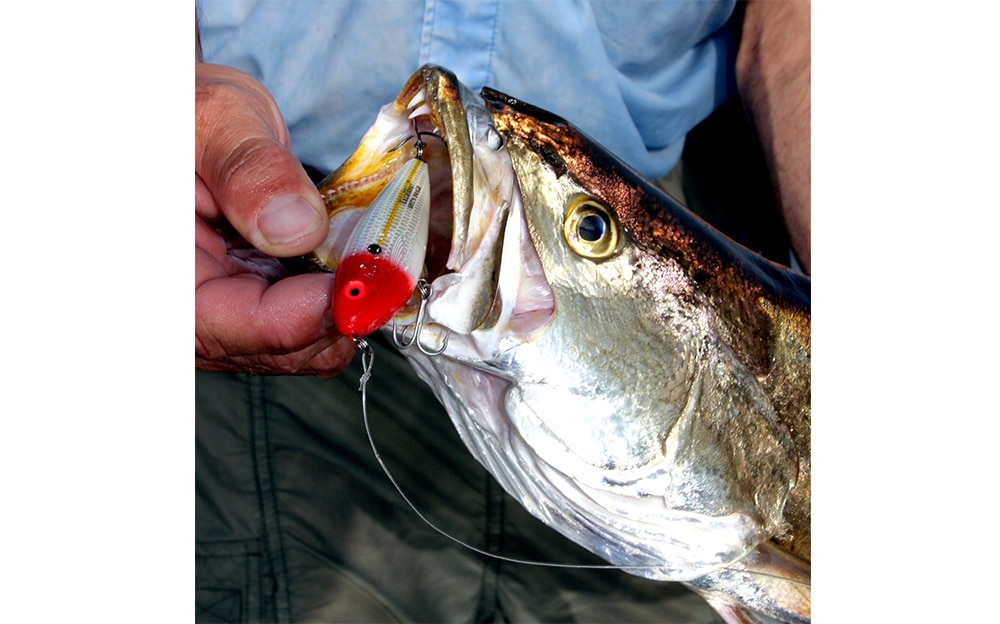
From May through September, bait stocks skyrocket, and with higher temperatures, fish scatter, often moving 30 miles and more up the St. Johns River, for example. Dawn, dusk and night fishing are most productive, anywhere bait is abundant. Hard-running tides are best, and deeper water — eight to 12 feet — is a key factor in locating trout. Submerged shell bars, important for holding feeding trout, also produce good catches of redfish and flounder. Almost any dock throughout the lower St. Johns River, St. Augustine and Fernandina Beach, and along much of the ICW, can be choice for summer trout, especially at night when lights draw bait.
Fall Fishing for Speckled Seatrout
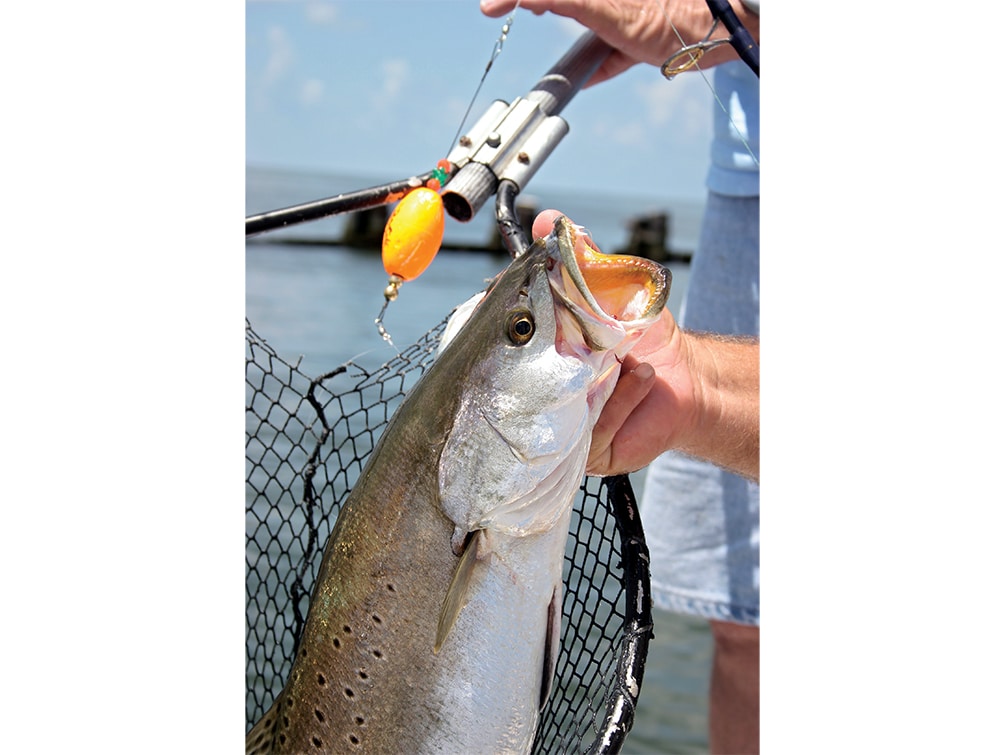
October through November is the height of the mullet and shrimp run, and where such baits are found en masse, trout and other game fish are nearby. The lower reaches of major rivers and inlets offer great fishing, and surf casters get into the action with trout and other species when mullet are moving along area beaches.
One October morning, my wife, Chris, and son Eric and I fished docks at dawn for seatrout in the lower St. Johns River. We hit the fish and tide just right, and caught about 30 trout, plus two redfish and three flounder, and were back home by 10 a.m.
I talked to two buddies that night at a party. Both had fished that morning too. One had caught a six-fish limit of seatrout from the surf while casting live shrimp from the Jacksonville Beach Pier. The other friend had fished Fort George Inlet from his kayak, and while he caught more flounder and redfish than trout, he still collected a limit of six fish to 3 pounds. Now that’s good fishing by any area standard and over a huge coastal region.
Northeast Florida Seatrout Fishing Tips
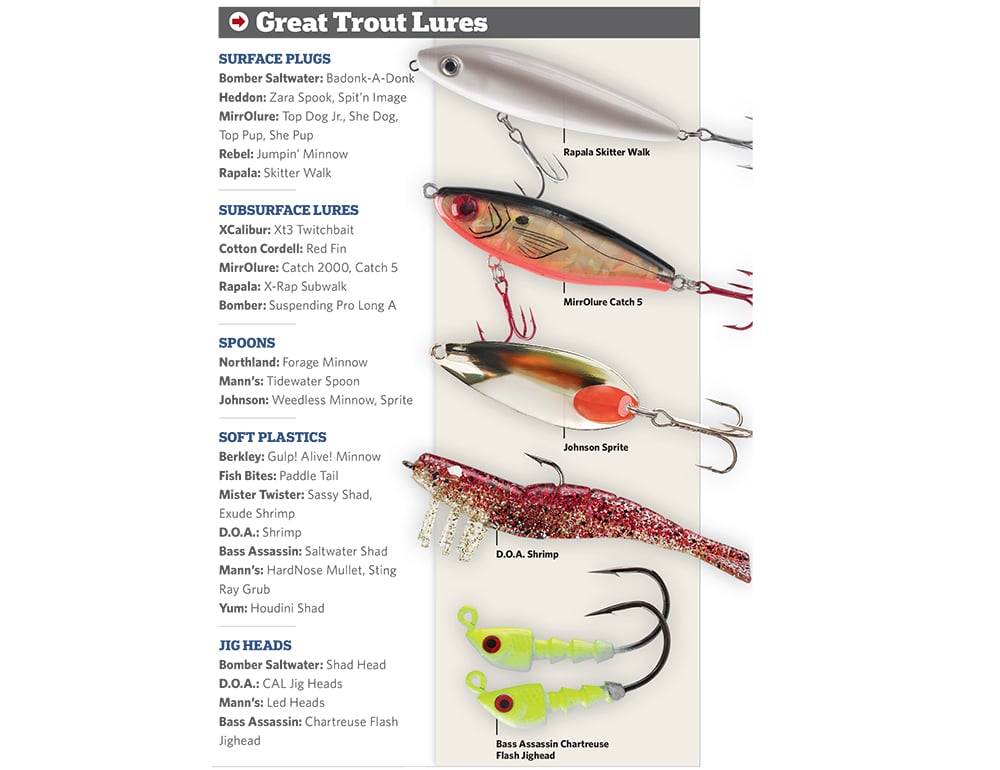
- Who: The best spotted seatrout action happens from Fernandina Beach to Matanzas Inlet most years. What has caused this surge in trout fishing? First, this part of the state is a smorgasbord of fresh water flowing through six inlets along 50 miles of coast. The tidal habitat is ideal for trout, red drum, flounder, black drum, common weakfish and tarpon.
- What: Seatrout, redfish, flounder and other species
- Where: Matanzas Inlet; St. Augustine; the lower St. Johns River from the mouth to the ICW; Fort George River and Inlet; the lower Nassau River; Fernandina Beach; and countless and nameless tidal creeks along 50 miles of the ICW









